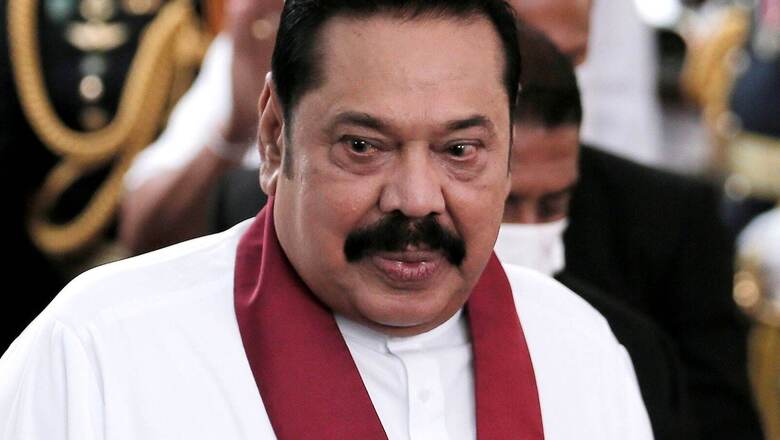
views
The unprecedented forex crisis in Sri Lanka has evolved into a blazing political tumult riddled with violence. As protestors take to the streets all across the island nation, the Rajapaksa dynasty of Sri Lanka appears to be running on borrowed time. Even as Mahinda Rajapaksa resigns as Prime Minister, the anger of protestors has not simmered down as they demand the last standing Rajapaksa— President Gotabaya to step down. Meanwhile, Sri Lanka’s Central Bank governor has threatened to resign if a stable government is not formed within two days beyond which he says the economy will “completely collapse and no one will be able to save it.”
The Rajapaksas, however, are preoccupied with retaining power. Shoot-at-sight orders have been issued to quell the unrest after several vehicles and buildings were set ablaze and 7 people were killed including a ruling party MP amid clashes between the pro-Rajapaksa and anti-Rajapaksa protestors. Many of the Rajapaksas’ own properties were torched by the mob apart from those of the ruling party SLPP’s lawmakers. The ancestral home of the Rajapaksas was set ablaze in Hambantota. The most gruesome event however that will leave a mark on the Rajapaksas’ tainted legacy is the purported suicide of an SLPP lawmaker who shot 3 protesters, killing one and later proceeded to kill himself while being surrounded by a mob of angry protestors. Meanwhile, the Sri Lankan Army marched into Mahinda Rajapaksa’s Prime Ministerial residence and airlifted him from the besieged premises to a naval base in the country.
Sri Lanka has defaulted on its entire $51 billion worth of external debt obligations after expending 70% of its forex reserves in two years. With a soaring current account deficit and a crippling budgeting shortage to finance imports, the island is scrambling for food, fuel and medicines, and the Sinhalese rupee has fallen by nearly half its value this year, sending inflation through the roof. This financial mayhem has spooked investors and citizens have run out of patience with those in power, which is why the Rajapaksas are caught in an unforgiving storm that may finally usher the end of the family fiefdom they’ve been running in Sri Lanka.
The end of the fiefdom
Mahinda Rajapaksa’s move to step down, and the mass resignations of ministers before this, failed to placate the protesters and emboldened them further to not stop until the last Rajapaksa is sacked. This threatens the future of the powerful Rajapaksa dynasty which may not go down without a fight. Gotabaya Rajapaksa’s last resort is calling in the army, which is known to be loyal to him, to curb the unrest. The President and the Sri Lankan Army go a long way as he led the forces into the endgame with Tamil insurgents in the late 2000s under his brother Mahinda’s rule. As secretary to the ministry of defence, he is known to have been the one steering Sri Lanka’s war machine. Brazen human rights violations were reported during this time but as the war ended in 2009 with the death of the powerful Tamil commander Velupillai Prabhakaran, the majority Sinhalese Buddhist community of Sri Lanka thanked the Rajapaksa brothers and even gave Gotabaya the moniker ‘Terminator’ which went on to form the core of his electoral pitch in 2019 when he was elected President in a landslide victory following devastating bomb blasts in an Islamist terror attack that shook the island nation back into security paranoia.
Also Read: The Sri Lankan Collapse: Colombo Must Get Its Act Straight and Keep The China Card on a Leash
Gotabaya Rajapaksa went on to appoint his older brother and former President, Mahinda Rajapaksa as the Prime Minister of his government. Three other members of the family held key portfolios in the ministerial cabinet including finance, youth affairs and irrigation, until they were forced to resign owing to the spiralling economic crisis.
The Rajapaksa family has been entrenched in Sri Lankan politics for decades now. Born to a political family, Mahinda Rajapaksa started his political career at the age of 21 and was elected to the house of representatives in 1970. His career saw many twists and turns until he became the Prime Minister in 2004 and the President in 2005. His popularity began to erode over time as apart from the financial corruption and mismanagement, his government, stained by its excesses during the war, addressed a dearth of investors by enthusiastically welcoming predatory investment from China. As a result of these policies, the Sri Lankan government infamously ended up defaulting on Chinese investments in the Hambantota port and gave it up to Beijing for 99 years, effectively confirming fears that the island nation had become a Chinese colony. The Rajapaksas clawed their way back to power in 2019, but the economic storm was long in the making and subsequent blows to the already embattled Sri Lankan economy were the last straw before matters turned into a full-scale crisis.
The Rajapaksas promised heavy tax cuts and delivered on them after being elected to power without considering the fiscal feasibility of such a move. It emptied the government’s already depleted coffers and to meet the gap, was followed by an overnight ban on imports of chemical fertilisers, backed by starry-eyed socialist advisors, that ran the agri-economy of the country to the ground in six months. Then came Covid, which starved the crucial tourism industry of the island nation and it was finally the Russian invasion of Ukraine which served as the finishing blow to the little island nation. As the forex reserves dwindled under $2 billion, imports choked, currency tanked and inflation soared to unprecedented levels, the Rajapaksas’ majoritarian brand of politics failed to appease the populace and even the Sinhalese Buddhist monks have turned hostile toward the Rajapaksa dynasty.
A tough road ahead
Sri Lanka now needs $20 billion to get out of the hole it has dug itself in. The President may fight back through force for as long as the army stands by him and buys him time to deal with the IMF for a bailout package. If Gotabaya Rajapaksa relents and resigns to give way to an interim government, this ruthless crisis may keep the Rajapaksas out of power for a long time to come. Either way, in the absence of a sturdy opposition, the island nation is at risk of being meddled with by powers like China which has so far stood watching as the crisis unfolds. A political vacuum may dash Sri Lanka’s chances of getting urgent relief and may throw it in the arms of forces inimical to India jeopardising India’s security paradigm in the Indian Ocean Region.
Sri Lanka’s twin deficit is poised to inflict prolonged suffering on the island nation’s economy. The country has its work cut out— starting with seeking a rescue package from the IMF, more credit from countries like India and China, and the restructuring of existing debt. Only then can it set along the path of undoing decades of fiscal mismanagement. Whether the Rajapaksas will outlast this process of rescue, restructuring and reform is yet to be seen but their chances are shrinking with each passing day.
Read all the Latest Opinions here




















Comments
0 comment